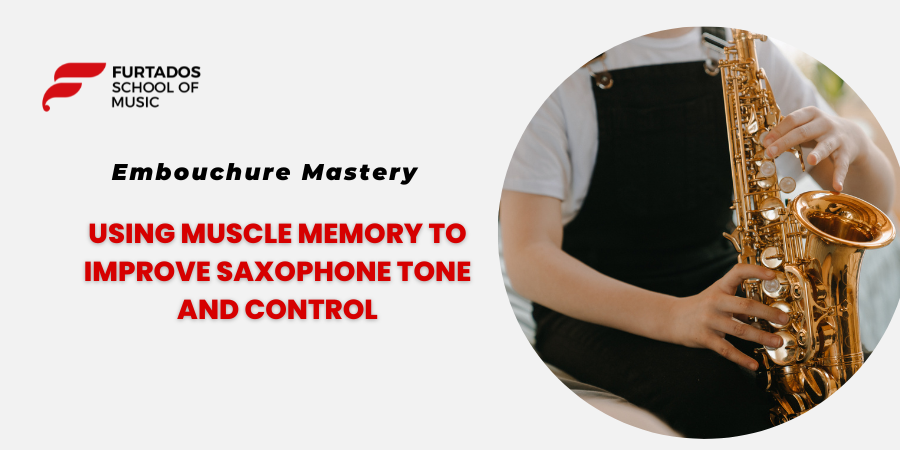Are you eager to learn saxophone, whether through saxophone classes near you or learn saxophone online? Playing the saxophone involves more than just mastering fingerings; it requires the development of a strong embouchure – the position and use of the lips, facial muscles, and tongue to produce sound. In this article, we will explore the role of muscle memory in achieving embouchure mastery and provide exercises to help you attain better tone and control on the saxophone. We’ll also introduce you to the educational opportunities available at the Furtados School of Music to further enrich your saxophone journey.
The Role of Muscle Memory in Saxophone Playing
Muscle memory is the ability of our muscles to remember and repeat specific movements through repetitive practice. In saxophone playing, muscle memory plays a crucial role in developing a strong embouchure, which, in turn, affects the quality of sound and control over the instrument. Here’s how muscle memory impacts your saxophone journey:
- Embouchure Formation: When you consistently practice proper embouchure formation, your facial muscles and lips adapt to the correct position over time. This muscle memory helps you achieve a consistent and reliable embouchure when you play.
- Tone Quality: Muscle memory aids in producing a consistent and desirable tone on the saxophone. It enables you to maintain the right lip and tongue positions, resulting in a clearer, more controlled sound.
- Dynamic Control: The ability to control dynamics and nuances in your saxophone playing, such as crescendos and decrescendos, relies on muscle memory. Your embouchure muscles remember the necessary adjustments to achieve these effects.
- Articulation: Muscle memory contributes to precise articulation, allowing you to articulate notes crisply and cleanly, whether it’s staccato or legato.
Exercises for Developing Muscle Memory in Saxophone Playing
Now, let’s delve into exercises and techniques that will help you harness muscle memory for embouchure mastery on the saxophone:
- Long Tones: Long Saxophone Tone are one of the most effective exercises for developing muscle memory in your embouchure. Start by playing a single note, such as middle C, as long and as evenly as possible. Focus on maintaining a consistent embouchure and tone throughout.
- Embouchure Flexibility: Practice switching between different notes while maintaining the same embouchure formation. Start with adjacent notes and gradually expand to larger intervals. This exercise helps your muscles adapt to changes in pitch.
- Dynamic Control: Play scales or simple melodies while focusing on dynamic control. Begin softly and gradually increase the volume, then decrease it again. This exercise trains your muscles to respond to changes in intensity.
- Articulation Exercises: Work on articulation exercises, such as tonguing patterns and slurred articulation. These exercises refine your tongue’s muscle memory for precise note articulation.
- Scales and Arpeggios: Incorporate scales and arpeggios into your practice routine. Play them slowly and gradually increase the tempo. Focus on maintaining a steady embouchure and consistent tone throughout the scales.
- Sustained Vibrato: Practice adding vibrato to sustained notes. This technique requires subtle muscle adjustments in your embouchure. Start slow and gradually increase the speed of your vibrato.
- Altissimo Register: Developing muscle memory for the altissimo register, the higher range of the saxophone, is essential for advanced players. Practice scales and exercises in this register to enhance your embouchure control.
The Role of Furtados School of Music
The Furtados School of Music offers invaluable resources and guidance to enhance your saxophone learning experience:
- Expert Instructors: Whether you’re attending saxophone classes near you or participating in learn saxophone online courses, the school provides expert instruction to help you develop embouchure mastery and muscle memory effectively.
- Structured Curriculum: Furtados offers a structured curriculum that gradually introduces and reinforces embouchure techniques and muscle memory development. The curriculum covers scales, exercises, and melodies with a focus on tone and control.
- Performance Opportunities: The school encourages students to participate in recitals and performances, where embouchure mastery and muscle memory are applied practically. This boosts your confidence and stage presence.
- Community and Resources: Being part of the Furtados community provides access to fellow saxophonists, educational materials, and a supportive network of learners.
- Feedback and Evaluation: Furtados instructors offer feedback and evaluations to help you gauge your progress in embouchure development and muscle memory, providing insights for improvement.
In conclusion, if you aspire to learn saxophone, harnessing muscle memory for embouchure mastery is a vital step in your musical journey. Whether you choose saxophone classes near you or opt for learn saxophone online, the ability to develop and apply muscle memory effectively will significantly enhance your tone quality and control. Embrace these exercises, practice consistently, and you’ll find yourself producing beautiful melodies and achieving greater precision on the saxophone. Enrolling in courses at the Furtados School of Music can further enhance your saxophone journey by providing expert guidance and a supportive learning environment that encourages embouchure mastery and musical fluency.
